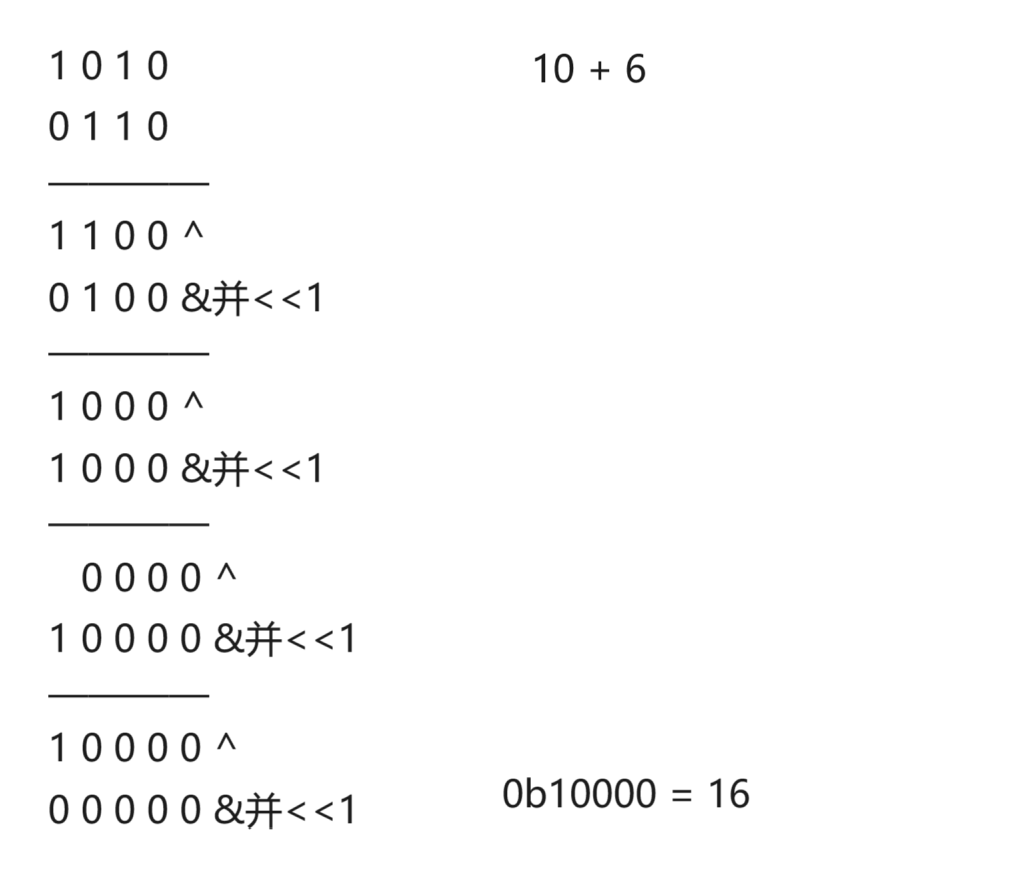
1. 另类加法
给定两个int A和B。编写一个函数返回A+B的值,但不得使用+或其他算数运算符。
测试样例:
1,2
返回:3
示例 1
输入
输出
思路1:
二进制0101和1101的相加
0 1 0 1
1 1 0 1
其实就是
不带进位的结果1000
和进位产生的1010相加
无进位加法: 两个二进制数异或后得到的结果
就是它们无进位相加的结果
进位: 两个二进制数按位与后左移1位
就是它们相加的进位结果
在每一轮计算中
利用异或运算符计算不进位部分
利用与运算符和左移运算符计算进位部分
并将进位部分赋值给另一个操作数
直到没有进位为止
最终,不进位部分的结果即为加法的结果

class UnusualAdd {
public:
int addAB(int A, int B) {
while (B) {
int a = A ^ B;
int b = (A & B) << 1;
A = a;
B = b;
}
return A;
}
};
2. 走方格的方案数
请计算n*m的棋盘格子(n为横向的格子数,m为竖向的格子数)从棋盘左上角出发沿着边缘线从左上角走到右下角,总共有多少种走法,要求不能走回头路,即:只能往右和往下走,不能往左和往上走。
注:沿棋盘格之间的边缘线行走
数据范围:
输入描述
输入两个正整数n和m,用空格隔开。(1≤n,m≤8)
输出描述
输出一行结果
示例 1
输入
2 2
输出
6
思路1: 递归
本题说的是沿着边缘线走
而非在格子里面走
第一步可以往右或往下
起始路径(0, 0)可以选择沿着
(0+1, 0)和(0, 0+1)的路径走
而(0+1, 0)和(0, 0+1)是起始路径(0, 0)的子问题
继续往下递归,用(i, j)表示当前位置
后续限制边界的向下或向右
因为不能走回头路
当向下(向右)走到边界
表示只有向右(向下)这一条路径可走
即可结束递归,无需完全走到右下角



#include <iostream>
using namespace std;
int scheme(int i, int j, int n, int m)
{
if (i == n || j == m)
return 1;
return scheme(i + 1, j, n, m) + scheme(i, j + 1, n, m);
}
int main() {
int n, m;
while (cin >> n >> m) {
cout << scheme(0, 0, n, m) << endl;
}
return 0;
}
思路2: 动态规划
用dp[i][j]表示到第 i 行 j 列为止的路径数
它等于到它左边的路径数
加上到它上边的路径数的总和
如果是首行或者首列路径数为1

(0, 0)到(0, 1)只有1条路径
(0, 0)到(1, 0)也只有1条路径
(0, 0)到(1, 1)的路径等于
它左边的路径加上它上边的路径
(0, 0)到(0, 1)的路径加上(0, 0)到(1, 0)的路径
1 + 1 = 2
int main() {
int n, m;
while(cin >> n >> m){
vector<vector<int>> dp(n + 1, vector<int>(m + 1, 0));
//dp[i][j]表示到第i行j列为止的路径数
for(int i = 0; i <= n; i++)
for(int j = 0; j <= m; j++){
if(i == 0 && j == 0) //起始位置只有一条路径
dp[i][j] = 1;
else if(i == 0) //起始行,等于左边列的路径
dp[i][j] = dp[i][j - 1];
else if(j == 0) //起始列,等于上边行的路径
dp[i][j] = dp[i - 1][j];
else //等于左边加上边的路径
dp[i][j] = dp[i][j - 1] + dp[i - 1][j];
}
cout << dp[n][m] << endl;
}
return 0;
}
3. 井字棋
给定一个二维数组board,代表棋盘,其中元素为1的代表是当前玩家的棋子,0表示没有棋子,-1代表是对方玩家的棋子。当一方棋子在横竖斜方向上有连成排的及获胜(及井字棋规则),返回当前玩家是否胜出。
测试样例:
[[1,0,1],[1,-1,-1],[1,-1,0]]
返回:true
示例 1
输入
输出
思路1:
先判断两个对角线
再for循环判断横纵
class Board {
public:
bool checkWon(vector<vector<int> > board) {
if (board[0][0] + board[1][1] + board[2][2] == 3
|| board[0][2] + board[1][1] + board[2][0] == 3)
return true;
for (int i = 0; i < board.size(); i++) {
if (board[i][0]+board[i][1]+board[i][2] == 3)
return true;
if (board[0][i]+board[1][i]+board[2][i] == 3)
return true;
}
return false;
}
};
4. 密码强度等级
密码按如下规则进行计分,并根据不同的得分为密码进行安全等级划分。
一、密码长度:
5 分: 小于等于4 个字符
10 分: 5 到7 字符
25 分: 大于等于8 个字符
二、字母:
0 分: 没有字母
10 分: 密码里的字母全都是小(大)写字母
20 分: 密码里的字母符合”大小写混合“
三、数字:
0 分: 没有数字
10 分: 1 个数字
20 分: 大于1 个数字
四、符号:
0 分: 没有符号
10 分: 1 个符号
25 分: 大于1 个符号
五、奖励(只能选符合最多的那一种奖励):
2 分: 字母和数字
3 分: 字母、数字和符号
5 分: 大小写字母、数字和符号
最后的评分标准:
= 90: 非常安全
= 80: 安全(Secure)
= 70: 非常强
= 60: 强(Strong)
= 50: 一般(Average)
= 25: 弱(Weak)
= 0: 非常弱(Very_Weak)
对应输出为:
VERY_SECURE
SECURE
VERY_STRONG
STRONG
AVERAGE
WEAK
VERY_WEAK
请根据输入的密码字符串,进行安全评定。
注:
字母:a-z, A-Z
数字:0-9
符号包含如下: (ASCII码表可以在UltraEdit的菜单view->ASCII Table查看)
!"#KaTeX parse error: Can't use function '\]' in math mode at position 76: …I码:0x3A~0x40) [\̲]̲^_` …@NoNoN
输出
VERY_SECURE
说明
样例的密码长度大于等于8个字符,得25分;大小写字母都有所以得20分;有两个数字,所以得20分;包含大于1符号,所以得25分;由于该密码包含大小写字母、数字和符号,所以奖励部分得5分,经统计得该密码的密码强度为25+20+20+25+5=95分。
示例 2
输入
Jl)M:+
输出
AVERAGE
说明
示例2的密码强度为10+20+0+25+0=55分。
思路1:
用好 if 和 else
对每个安全等级进行判断
#include <iostream>
using namespace std;
int passwordLength(string& s) {
if (s.size() >= 5 && s.size() <= 7)
return 10;
else if (s.size() >= 8)
return 25;
else return 5;
}
int passwordLetter(string& s) {
bool Capital = false, Lowercase = false;
for (int i = 0; i < s.size(); i++) {
if (s[i] >= 'A' && s[i] <= 'Z')
Capital = true;
else if (s[i] >= 'a' && s[i] <= 'z')
Lowercase = true;
}
if (Capital == false && Lowercase == false)
return 0;
else if (Capital == true && Lowercase == true)
return 20;
else return 10;
}
int passwordFigure(string& s) {
int count = 0;
for (int i = 0; i < s.size(); i++) {
if (s[i] >= '0' && s[i] <= '9')
count++;
if (count > 1) return 20;
}
if (count == 0) return 0;
else return 10;
}
int passwordSymbol(string& s) {
int count = 0;
for (int i = 0; i < s.size(); i++) {
if (s[i] >= 0x21 && s[i] <= 0x2F) count++;
else if (s[i] >= 0x3A && s[i] <= 0x40) count++;
else if (s[i] >= 0x5B && s[i] <= 0x60) count++;
else if (s[i] >= 0x7B && s[i] <= 0x7E) count++;
}
if (count == 0) return 0;
else if (count == 1) return 10;
else return 25;
}
int passwordAward(int Letter, int Figure, int Symbol) {
if (Letter == 20 && Figure >= 10 && Symbol >=10)
return 5;
else if (Letter == 10 && Figure >= 10 && Symbol >=10)
return 3;
else if (Letter == 10 && Figure >= 10)
return 2;
else return 0;
}
int main() {
string s;
cin >> s;
int Length, Letter, Figure, Symbol, Award;
Length = passwordLength(s);
Letter = passwordLetter(s);
Figure = passwordFigure(s);
Symbol = passwordSymbol(s);
Award = passwordAward(Letter, Figure, Symbol);
int score = Length + Letter + Figure + Symbol + Award;
if (score >= 90) cout << "VERY_SECURE" << endl;
else if (score >= 80) cout << "SECURE" << endl;
else if (score >= 70) cout << "VERY_STRONG" << endl;
else if (score >= 60) cout << "STRONG" << endl;
else if (score >= 50) cout << "AVERAGE" << endl;
else if (score >= 25) cout << "WEAK" << endl;
else if (score >= 0) cout << "VERY_WEAK" << endl;
return 0;
}
class password {
public:
password(string& s)
: _pwd(s)
{}
void passwordLength() {
if (_pwd.size() >= 5 && _pwd.size() <= 7)
_score += 10;
else if (_pwd.size() >= 8)
_score += 25;
else if (_pwd.size() <= 4) _score += 5;
}
void passwordLetter() {
for (auto l : _pwd) {
if (isupper(l))
_bigLetter = true;
else if (islower(l))
_smallLetter = true;
}
if (_bigLetter && _smallLetter)
_score += 20;
else if (_bigLetter || _smallLetter )
_score += 10;
}
void passwordFigure() {
int count = 0;
for (auto f : _pwd) {
if (isdigit(f)) count++;
}
if (count >= 1) _Figure = true;
if (count == 1) _score += 10;
else if (count > 1) _score += 20;
}
void passwordSymbol() {
int count = 0;
for (auto c : _pwd) {
if (ispunct(c))
count++;
}
if (count >= 1) _Symbol = true;
if (count == 1) _score += 10;
else if (count > 1) _score += 25;
}
void passwordAward() {
if (_bigLetter && _smallLetter && _Figure && _Symbol)
_score += 5;
else if ((_bigLetter || _smallLetter) && _Figure && _Symbol)
_score += 3;
else if ((_bigLetter || _smallLetter) && _Figure)
_score += 2;
}
void getTotalScore() {
passwordLength();
passwordLetter();
passwordFigure();
passwordSymbol();
passwordAward();
}
void _printGrade() {
getTotalScore();
if (_score >= 90) cout << "VERY_SECURE" << endl;
else if (_score >= 80) cout << "SECURE" << endl;
else if (_score >= 70) cout << "VERY_STRONG" << endl;
else if (_score >= 60) cout << "STRONG" << endl;
else if (_score >= 50) cout << "AVERAGE" << endl;
else if (_score >= 25) cout << "WEAK" << endl;
else if (_score >= 0) cout << "VERY_WEAK" << endl;
}
private:
string _pwd;
int _score = 0;
bool _bigLetter = false;
bool _smallLetter = false;
bool _Figure = false;
bool _Symbol = false;
};
int main() {
string s;
while (cin >> s) {
password pwd(s);
pwd._printGrade();
}
return 0;
}









![前端vue打印后端对象为[object,object]](https://i-blog.csdnimg.cn/direct/253030d69a4540c1877a263757bc96dd.png)









